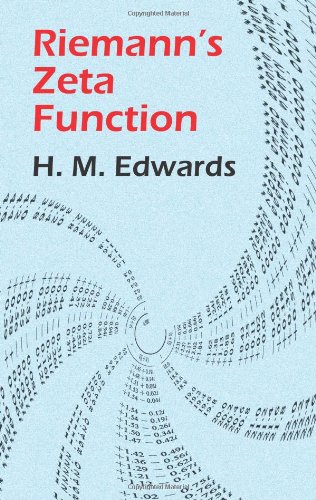Riemann's Zeta Function book
Par hernandez daniel le lundi, mai 30 2016, 01:12 - Lien permanent
Riemann's Zeta Function by H. M. Edwards


Riemann's Zeta Function H. M. Edwards ebook
ISBN: 0122327500, 9780122327506
Publisher: Academic Press Inc
Format: pdf
Page: 331
What happens if we take {X} to be a variety over a finite field {\mathbb{F}_q} ? We recover the classical Riemann zeta function, and taking the ring of integers of a number field recovers the zeta function of a number field. If we can't yet say for sure that Re(s) = 1/2 for all s such that ζ(s) = 0, what can we say? Apparently it tends to infinity when the argument is 1. So I was reading The Music of the Primes and I obviously came across the Zeta function. \displaystyle \sum_{m=2}^{\infty}\frac. An Interesting Sum Involving Riemann's Zeta Function. So-defined because it puts the functional equation of the Riemann zeta function into the neat form $\xi(1-s) = \xi(s)$. If we look at the Taylor expansion. Discription of Leonard Euler's discovery of his product formula. But right in the middle there is a discussion of Bernhard Riemann's zeta function, which in my (albeit layman's understanding) is concerned with predicting the distribution of prime numbers. Graph the Riemann Zeta Function and watch the recursive spiraling through recursive loops, only to miraculously escape the predictable. Derivation is given, along with it's connction to the famous Riemann zeta function. Progress towards establishing the Riemann hypothesis could be viewed in terms of giving tighter limits on Re(s). $$\xi(s) = (s-1) \pi^{-s/2} \Gamma\left(1+\tfrac{1}{2} s\right) \zeta(s),$$. Point of post: In this post we shoe precisely we compute the radius of convergence of the the power series. See within this graph the narrative structure of every tale you've ever read. In this post I will talk about an analogue between the Riemann zeta function and the tuning system used in Western music. Given img.top {vertical-align:15%;} and img.top {vertical-align:15%;} , show img.top {vertical-align:15%;} . I goes like this: 1 + 1/2 + 1/3 + 1/4 + 1/5 + .